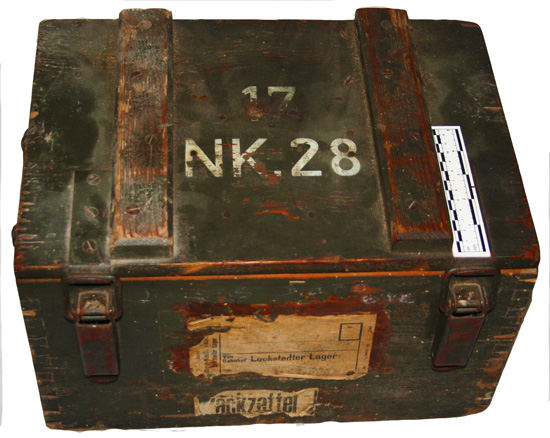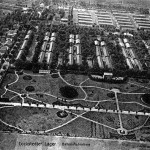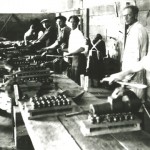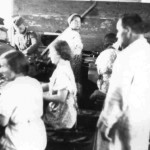Artifact Highlight: German Ammo Crate

Sometimes even the most mundane artifact is weighted with the burden of history. Take this wooden German ammunition crate, for example. It was used to hold smoke grenades. At first glance, the crate seems quite ordinary. However, an examination of the packing label unearthed some information about Nazi Germany’s slave labor system. This particular crate from the Museum’s collection was shipped to the German army from the Lockstedter Lager train station. What was the Lockstedter Lager, you ask?
The Lockstedter Lager began as a training camp for the Imperial German Army in 1872. Located in the low-lying region of Holstein in northern Germany, thousands of soldiers trained there yearly. After 1918, a sprawling military complex was left in the camp’s wake. During the Weimar Republic, groups of extreme right-wing paramilitary extremists, including the Freikorps, used this facility. Such paramilitary organizations later formed the nucleus of the Nazi party.
During the 1930s, the lager became a training facility for the Sturmabteiling (SA), well known as the infamous Brownshirts. By 1938, a Heeresmunitionsanstalt (Muna), or munitions assembly plant, was added to the complex along with barracks for slave laborers and prisoners-of-war. Here, separate components of ammunition were assembled and armed, then packed into crates and shipped to various units. These assembly plants were scattered throughout Germany and were usually located in isolated areas like forests in order to minimize damage to the surrounding community in the event of an accident or air raid. The Lockstedter Lager was no exception; it stood on its own in the middle of a sparsely populated part of Holstein, making it ideally located for munitions assembly.
- Aerial view of the Lockstedter Lager c. 1908
- Slave laborers in Heeresmunitionsanstalt Volpriehausen. Photo courtesy of Heimatverein Volpriehausen e.V.
- Slave laborers and German personnel in Heeresmunitionsanstalt Volpriehausen. Photo courtesy of Heimatverein Volpriehausen e.V.
The Lockstedter Lager was just like any other Muna. By 1944, the Muna had grown from a size of 1,000 workers to over 4,000. Of these 4,000, a majority were Zwangsarbeiter, or slave laborers from regions conquered by the Third Reich. The Third Reich enslaved over 12 million men and women over the course of the war. Of these, 7.6 million were enslaved in Germany itself, and more than half were women or teenage girls. These people were sent to Germany via train, and most were either housed on-site or in a satellite for a larger concentration camp. The laborers came from all manner of regions and were forced to work in factories, agriculture, mines, and public utilities. The majority came from Poland and the Soviet Union, victims of Nazi Germany’s racial crusade in the East. Others were prisoners-of-war and concentration camp prisoners from all of Nazi Germany’s “racial enemies.”
In late 1944, Lockstedter Lager began to house German refugees fleeing from the rapid Soviet advance in the East. At the end of the war, Lockstedter Lager was used as a camp for Displaced Persons, or DPs. These were mostly Eastern European refugees that had previously been slave laborers or concentration camp inmates. Today, the ruins of Lockstedter Lager stand amidst the community of Hohenlockstedt.It is important to remember that the Third Reich’s war machine was fueled in part by modern-day slavery. Although at first glance a wooden ammunition crate may not seem like something with a particularly interesting background, the likelihood that it was assembled and packed by slave labor is a chilling reminder of the criminal nature of the Third Reich.
Post by Curatorial Intern Nick Johnson
- Posted :
- Post Category :
- Tags :
- Follow responses to this entry through the RSS 2.0 feed. You can skip to the end and leave a response. Pinging is currently not allowed.







Leave a Reply